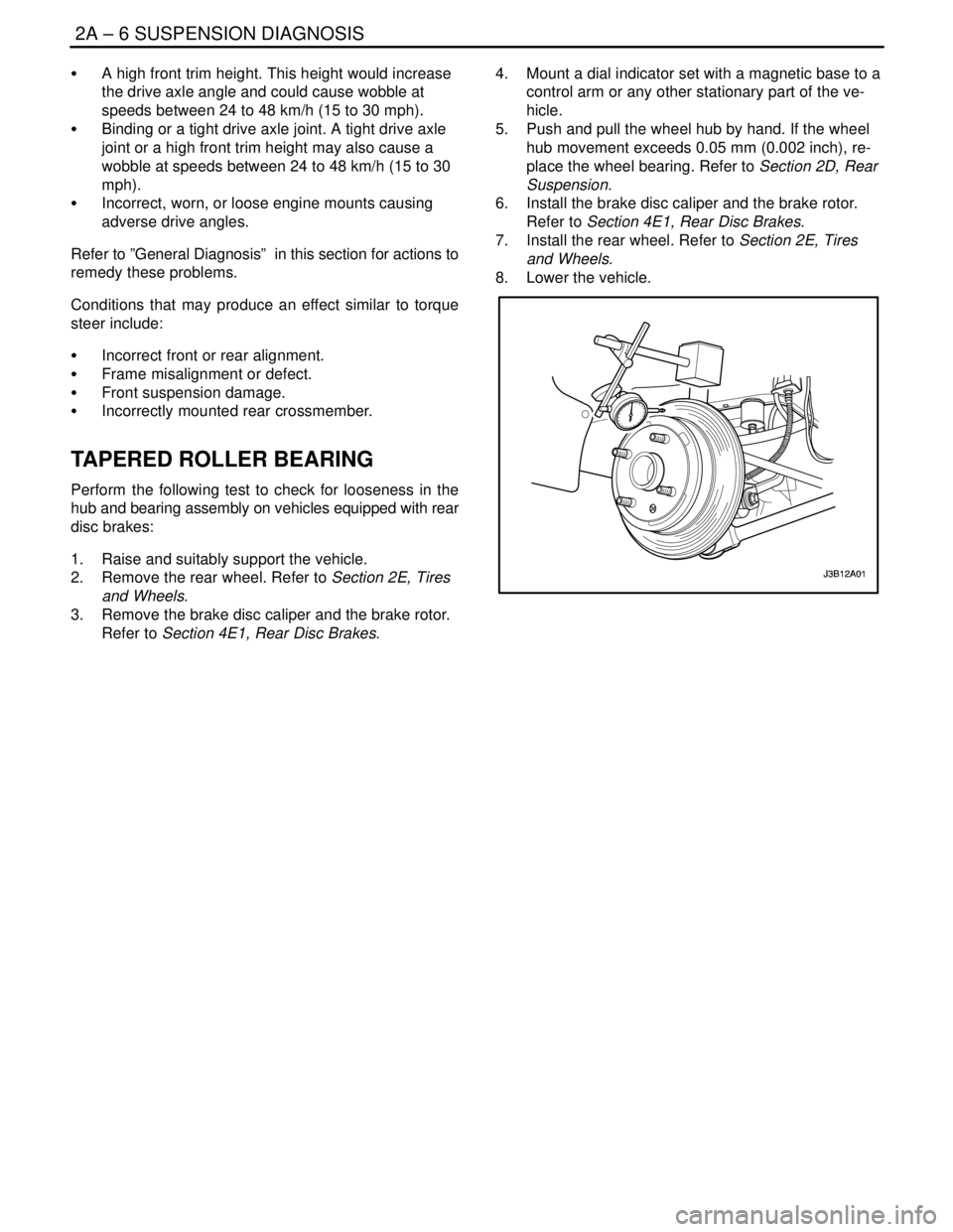2004 DAEWOO LACETTI wheel
[x] Cancel search: wheelPage 875 of 2643

ENGINE CONTROLS 1F – 629
DAEWOO V–121 BL4
tentially interfere with the operation of the Exhaust Gas
Recirculation (EGR) valve and thereby turn on the MIL.
Small leaks in the exhaust system near the post catalyst
oxygen sensor can also cause the MIL to turn on.
Aftermarket electronics, such as cellular phones, stereos,
and anti–theft devices, may radiate electromagnetic inter-
ference (EMI) into the control system if they are improperly
installed. This may cause a false sensor reading and turn
on the MIL.
Environment
Temporary environmental conditions, such as localized
flooding, will have an effect on the vehicle ignition system.
If the ignition system is rain–soaked, it can temporarily
cause engine misfire and turn on the MIL.
Refueling
A new EOBD diagnostic checks the integrity of the entire
Evaporative (EVAP) Emission system. If the vehicle is re-
started after refueling and the fuel cap is not secured cor-
rectly, the on–board diagnostic system will sense this as
a system fault, turn on the MIL, and set DTC P0440.
Vehicle Marshaling
The transportation of new vehicles from the assembly
plant to the dealership can involve as many as 60 key
cycles within 2 to 3 miles of driving. This type of operation
contributes to the fuel fouling of the spark plugs and will
turn on the MIL with a set DTC P0300.
Poor Vehicle Maintenance
The sensitivity of EOBD diagnostics will cause the MIL to
turn on if the vehicle is not maintained properly. Restricted
air filters, fuel filters, and crankcase deposits due to lack
of oil changes or improper oil viscosity can trigger actual
vehicle faults that were not previously monitored prior to
EOBD. Poor vehicle maintenance can not be classified as
a ”non–vehicle fault,” but with the sensitivity of EOBD
diagnostics, vehicle maintenance schedules must be
more closely followed.
Severe Vibration
The Misfire diagnostic measures small changes in the
rotational speed of the crankshaft. Severe driveline vibra-
tions in the vehicle, such as caused by an excessive
amount of mud on the wheels, can have the same effect
on crankshaft speed as misfire and, therefore, may set
DTC P0300.
Related System Faults
Many of the EOBD system diagnostics will not run if the
engine controlmodule (ECM) detects a fault on a related
system or component. One example would be that if the
ECM detected a Misfire fault, the diagnostics on the cata-
lytic converter would be suspended until the Misfire fault
was repaired. If the Misfire fault is severe enough, the cat-
alytic converter can be damaged due to overheating andwill never set a Catalyst DTC until the Misfire fault is re-
paired and the Catalyst diagnostic is allowed to run to
completion. If this happens, the customer may have to
make two trips to the dealership in order to repair the ve-
hicle.
SERIAL DATA COMMUNICATIONS
Class II Serial Data Communications
Government regulations require that all vehicle manufac-
turers establish a common communication system. This
vehicle utilizes the ”Class II” communication system. Each
bit of information can have one of two lengths: long or
short. This allows vehicle wiring to be reduced by transmit-
ting and receiving multiple signals over a single wire. The
messages carried on Class II data streams are also priori-
tized. If two messages attempt to establish communica-
tions on the data line at the same time, only the message
with higher priority will continue. The device with the lower
priority message must wait. Themost significant result of
this regulation is that it provides scan tool manufacturers
with the capability to access data from any make or model
vehicle that is sold.
The data displayed on the other scan tool will appear the
same, with some exceptions. Some scan tools will only be
able to display certain vehicle parameters as values that
are a coded representation of the true or actual value. On
this vehicle the scan tool displays the actual values for ve-
hicle parameters. It will not be necessary to perform any
conversions from coded values to actual values.
ON–BOARD DIAGNOSTIC (EOBD)
On–Board Diagnostic Tests
A diagnostic test is a series of steps, the result of which is
a pass or fail reported to the diagnostic executive. When
a diagnostic test reports a pass result, the diagnostic
executive records the following data:
S The diagnostic test has been completed since the
last ignition cycle.
S The diagnostic test has passed during the current
ignition cycle.
S The fault identified by the diagnostic test is not cur-
rently active.
When a diagnostic test reports a fail result, the diagnostic
executive records the following data:
S The diagnostic test has been completed since the
last ignition cycle.
S The fault identified by the diagnostic test is current-
ly active.
S The fault has been active during this ignition cycle.
S The operating conditions at the time of the failure.
Remember, a fuel trim Diagnostic Trouble Code (DTC)
may be triggered by a list of vehicle faults. Make use of all
information available (other DTCs stored, rich or lean con-
dition, etc.) when diagnosing a fuel trim fault.
Page 879 of 2643

ENGINE CONTROLS 1F – 633
DAEWOO V–121 BL4
Failed This Ig. (Failed This Ignition)
This message display indicates that the diagnostic test
has failed at least once during the current ignition cycle.
This message will clear when DTCs are cleared or the igni-
tion is cycled.
History
This message display indicates that the DTC has been
stored in memory as a valid fault. A DTC displayed as a
History fault may not mean that the fault is no longer pres-
ent. The history description means that all the conditions
necessary for reporting a fault have been met (maybe
even currently), and the information was stored in the con-
trol module memory.
MIL Requested
This message display indicates that the DTC is currently
causing the MIL to be turned ON. Remember that only
type A and type B DTCs can request the MIL. The MIL re-
quest cannot be used to determine if the DTC fault condi-
tions are currently being experienced. This is because the
diagnostic executive will require up to three trips during
which the diagnostic test passes to turn OFF the MIL.
Not Run Since CI (Not Run Since Cleared)
This message display indicates that the selected diagnos-
tic test has not run since the last time DTCs were cleared.
Therefore, the diagnostic test status (passing or failing) is
unknown. After DTCs are cleared, this message will con-
tinue to be displayed until the diagnostic test runs.
Not Run This Ig. (Not Run This Ignition)
This message display indicates that the selected diagnos-
tic test has not run during this ignition cycle.
Test Ran and Passed
This message display indicates that the selected diagnos-
tic test has done the following:
S Passed the last test.
S Run and passed during this ignition cycle.
S Run and passed since DTCs were last cleared.
If the indicated status of the vehicle is ”Test Ran and
Passed” after a repair verification, the vehicle is ready to
be released to the customer.
If the indicated status of the vehicle is ”Failed This Ignition”
after a repair verification, then the repair is incomplete and
further diagnosis is required.
Prior to repairing a vehicle, status information can be used
to evaluate the state of the diagnostic test, and to help
identify an intermittent problem. The technician can con-
clude that although the MIL is illuminated, the fault condi-
tion that caused the code to set is not present. An intermit-
tent condition must be the cause.
PRIMARY SYSTEM – BASED
DIAGNOSTICS
There are primary system–based diagnostics which eval-
uate system operation and its effect on vehicle emissions.
The primary system–based diagnostics are listed below
with a brief description of the diagnostic function:
Oxygen Sensor Diagnosis
The fuel control Front Heated Oxygen Sensor (HO2S1) is
diagnosed for the following conditions:
S Slow response.
S Response time (time to switch R/L or L/R).
S Inactive signal (output steady at bias voltage
approx. 450 mv).
S Signal fixed high.
S Signal fixed low.
The catalyst monitor Rear Heated Oxygen Sensor
(HO2S2) is diagnosed for the following conditions:
S Heater performance (time to activity on cold start).
S Signal fixed low during steady state conditions or
power enrichment (hard acceleration when a rich-
mixture should be indicated).
S Signal fixed high during steady state conditions or
deceleration mode (deceleration when a lean mix-
ture should be indicated).
S Inactive sensor (output steady at approximately 438
mv).
If the oxygen sensor pigtail wiring, connector or terminal
are damaged, the entire oxygen sensor assembly must be
replaced. Do not attempt to repair the wiring, connector or
terminals. In order for the sensor to function properly, it
must have clean reference air provided to it. This clean air
reference is obtained by way of the oxygen sensor wire(s).
Any attempt to repair the wires, connector or terminals
could result in the obstruction of the reference air and de-
grade oxygen sensor performance.
Misfire Monitor Diagnostic Operation
The misfire monitor diagnostic is based on crankshaft
rotational velocity (reference period) variations. The en-
gine control module (ECM) determines crankshaft rota-
tional velocity using the Crankshaft Position (CKP) sensor
and the Camshaft Position (CMP) sensor. When a cylinder
misfires, the crankshaft slows down momentarily. By mon-
itoring the CKP and CMP sensor signals, the ECM can cal-
culate when a misfire occurs.
For a non–catalyst damaging misfire, the diagnostic will be
required to monitor a misfire present for between
1000–3200 engine revolutions.
For catalyst–damaging misfire, the diagnostic will respond
to misfire within 200 engine revolutions.
Rough roads may cause false misfire detection. A rough
road will cause torque to be applied to the drive wheels and
drive train. This torque can intermittently decrease the
crankshaft rotational velocity. This may be falsely de-
tected as a misfire.
Page 902 of 2643

SECTION : 2A
SUSPENSION DIAGNOSIS
TABLE OF CONTENTS
DIAGNOSIS2A–1 . . . . . . . . . . . . . . . . . . . . . . . . . . . . . . . .
General Diagnosis 2A–1. . . . . . . . . . . . . . . . . . . . . . . . . Torque Steer 2A–5. . . . . . . . . . . . . . . . . . . . . . . . . . . . . .
Tapered Roller Bearing 2A–6. . . . . . . . . . . . . . . . . . . . .
DIAGNOSIS
GENERAL DIAGNOSIS
Problems in the steering, the suspension, the tires, and
the wheels involve several systems. Consider all systems
when diagnosing a complaint. Some problems, such as
abnormal or excessive tire wear and scuffed tires, may be
the result of hard driving. Always road test the vehicle first.If possible, do this road test with the customer.
Proceed with the following preliminary checks. Correct
any substandard conditions.
Preliminary Checks
ChecksAction
Inspect the tires for improper pressure and uneven wear.Inflate the tires to the proper pressure.
Inspect the joint from the steering column to the steering
gear for loose connections or wear.Tighten the intermediate shaft pinch bolts. Replace the in-
termediate shaft as needed.
Inspect the front and the rear suspension, the steering
gear, and the linkage for loose or damaged parts.Tighten the front and the rear suspension. Tighten the
steering gear mounting bracket bolts. Tighten the coupling
flange pinch bolts. Replace the front and the rear suspen-
sion as needed. Replace the steering gear as needed. Re-
place the intermediate shaft as needed.
Inspect for out–of–round tires.Perform a free runout test. Match–mount the tires.
Inspect for out–of–balance tires, bent wheels, and worn or
loose wheel bearings.Balance the wheels. Replace the wheels. Replace the
wheel bearings.
Check the power steering pump serpentine belt tension.Tighten the power steering pump serpentine belt.
Inspect the power steering system for leaks. Check the
power steering fluid level.Repair any leaks. Perform a power steering gear test. Add
power steering fluid.
Car Lead/Pull
ChecksAction
Inspect for mismatched or uneven tires.Replace the tires.
Inspect for a broken or a sagging spring.Replace the spring.
Inspect for a radial tire lateral force.Check the wheel alignment. Switch the wheels. Replace
the tires as needed.
Check the front–wheel alignment.Align the front wheels.
Inspect for an off–center steering gear.Reseat the pinion valve assembly. Replace the pinion
valve assembly as needed.
Inspect for front–brake dragging.Adjust the front brakes.
Page 903 of 2643

2A – 2ISUSPENSION DIAGNOSIS
DAEWOO V–121 BL4
Abnormal or Excessive Tire Wear
ChecksAction
Check the front–wheel and the rear–wheel alignment.Align the front and the rear wheels.
Inspect for excessive toe on the front and the rear wheels.Adjust the toe on the front and the rear wheels.
Inspect for a broken or a sagging spring.Replace the spring.
Inspect for out–of–balance tires.Balance the tires.
Inspect for worn strut dampeners.Replace the strut dampeners.
Check for a failure to rotate tires.Rotate the tires. Replace the tires as needed.
Check for an overloaded vehicle.Maintain the proper load weight.
Inspect for low tire inflation.Inflate the tires to the proper pressure.
Scuffed Tires
ChecksAction
Inspect for incorrect toe on the front and the rear wheels.Adjust the toe on the front and the rear wheels.
Inspect for a twisted or a bent suspension arm.Replace the suspension arm.
Wheel Tramp
ChecksAction
Inspect for an out–of–balance tire or wheel.Balance the tire or the wheel.
Inspect for improper strut dampener action.Replace the strut dampeners.
Shimmy, Shake, or Vibration
ChecksAction
Inspect for an out–of–balance tire or wheel.Balance the tire or the wheel.
Inspect for excessive wheel hub runout.Measure the hub flange runout. Replace the hub as need-
ed.
Inspect for excessive brake drum or brake rotor imbal-
ance.Adjust the brakes. Replace the brake rotor or the brake
drum as needed.
Inspect for worn tie rod ends.Replace the outer tie rods.
Inspect for wheel trim imbalance.Balance the wheel.
Inspect for a worn lower ball joint.Replace the lower ball joint.
Inspect for excessive wheel runout.Measure the wheel runout. Replace the wheel as needed.
Inspect for excessive loaded radial runout on the tire and
wheel assembly.Match–mount the tire and wheel assembly.
Hard Steering
ChecksAction
Check the steering gear preload adjustment.Perform a rack bearing preload adjustment.
Check the hydraulic system. Test the power steering sys-
tem pressure with a gauge.Replace the seals and the hoses as needed.
Inspect for binding or catching in the steering gear.Lubricate the steering gear. Repair or replace the steering
gear as needed.
Inspect for a loose steering gear mounting.Tighten the steering gear mounting bracket nuts.
Page 904 of 2643

SUSPENSION DIAGNOSIS 2A – 3
DAEWOO V–121 BL4
Too Much Play in Steering
ChecksAction
Inspect for worn or loose wheel bearings.Tighten the drive axle nut. Replace the wheel bearings as
needed.
Inspect for a loose steering gear mounting.Tighten the steering gear mounting bracket nuts.
Inspect the joint from the column to the steering gear for
loose connections or wear.Tighten the intermediate shaft pinch bolts. Replace the in-
termediate shaft as needed.
Check the steering gear preload adjustment.Perform a rack bearing preload adjustment.
Poor Returnability
ChecksAction
Inspect for lack of lubrication of the ball joints and the tie
rod ends.Replace the ball joints and the outer tie rods.
Inspect for binding in the ball joints.Replace the ball joint.
Inspect for binding in the steering column.Lubricate the steering column. Replace the steering col-
umn as needed.
Check the front–wheel alignment.Align the front wheels.
Check the steering gear preload adjustment.Perform a rack bearing preload adjustment.
Inspect for a sticking valve.Lubricate the pinion valve assembly. Replace the pinion
valve assembly as needed.
Inspect for binding in the intermediate shaft on the steering
gear.Replace the intermediate shaft.
Abnormal Noise, Front Suspension
ChecksAction
Inspect for a lack of lubrication of the ball joints and the tie
rod ends.Replace the ball joints and the outer tie rods.
Inspect for damaged suspension components.Replace the damaged suspension components.
Inspect for worn control arm bushings or tie rod ends.Replace the control arm bushings or the tie rods.
Inspect for a loose stabilizer shaft link.Tighten the stabilizer shaft link.
Inspect for loose wheel bolts.Tighten the wheel bolts.
Inspect for loose suspension bolts or nuts.Tighten the suspension bolts or the nuts.
Inspect for worn strut dampeners or strut mountings.Replace the strut dampeners. Tighten the strut mounting
bolts.
Inspect for an improperly positioned strut spring.Adjust the strut spring to the proper position.
Wander or Poor Steering Ability
ChecksAction
Inspect for mismatched or uneven tires.Replace the tires.
Inspect for lack of lubrication of the ball joints and the tie
rod ends.Replace the ball joints and the outer tie rods.
Inspect for worn strut dampeners.Replace the strut dampeners.
Inspect for a loose stabilizer shaft link.Tighten the stabilizer shaft link.
Inspect for a broken or a sagging spring.Replace the spring.
Page 905 of 2643

2A – 4ISUSPENSION DIAGNOSIS
DAEWOO V–121 BL4
Checks Action
Check the steering gear preload adjustment.Perform a rack bearing preload adjustment.
Check the front–wheel and the rear–wheel alignment.Align the front and the rear wheels.
Erratic Steering when Braking
ChecksAction
Inspect for worn or loose wheel bearings.Replace the wheel bearings.
Inspect for a broken or a sagging spring.Replace the spring.
Inspect for a leaking wheel cylinder or caliper.Replace the wheel cylinder or the caliper.
Inspect for warped rotors.Replace the rotors.
Inspect for an incorrect or an uneven caster.If the caster is beyond specifications, check the frame and
repair it as needed.
Low or Uneven Trim Height
ChecksAction
Inspect for a broken or a sagging spring.Replace the spring.
Check for an overloaded vehicle.Maintain the proper load weight.
Inspect for an incorrect or weak spring.Replace the spring.
Ride Too Soft
ChecksAction
Inspect for worn strut dampeners.Replace the strut dampeners.
Inspect for a broken or a sagging spring.Replace the spring.
Ride Too Harsh
ChecksAction
Inspect for incorrect strut dampeners.Replace the strut dampeners.
Inspect for an incorrect spring.Replace the spring.
Body Leans or Sways in Corners
ChecksAction
Inspect for a loose stabilizer shaft link.Tighten the stabilizer shaft link.
Inspect for worn strut dampeners or strut mountings.Replace the strut dampeners. Tighten the strut assembly
mounting bolts.
Check for an overloaded vehicle.Maintain the proper load weight.
Inspect for a broken or a sagging spring.Replace the spring.
Suspension Bottoms
ChecksAction
Inspect for worn strut dampeners.Replace the strut dampeners.
Check for an overloaded vehicle.Maintain the proper load weight.
Inspect for a broken or a sagging spring.Replace the spring.
Page 906 of 2643

SUSPENSION DIAGNOSIS 2A – 5
DAEWOO V–121 BL4
Steering Wheel Kickback
ChecksAction
Inspect for air in the power steering system.Purge the power steering system of air.
Inspect for a loose steering gear mounting.Tighten the steering gear mounting bracket nuts.
Inspect the joint from the column to the steering gear for
loose connections or wear.Tighten the intermediate shaft pinch bolts. Replace the in-
termediate shaft as needed.
Inspect for loose tie rod ends.Tighten the tie rod ends. Replace the outer tie rods as
needed.
Inspect for loose or worn wheel bearings.Tighten the drive axle nut. Replace the wheel bearings as
needed.
Steering Wheel Surges or Jerks
ChecksAction
Check the hydraulic system. Test the power steering sys-
tem pressure with a gauge.Replace the seals and the hoses as needed.
Inspect for a sluggish steering gear valve.Clean the pinion valve assembly. Replace the pinion valve
assembly as needed.
Inspect for a loose power steering pump serpentine belt.Adjust the power steering pump serpentine belt.
Cupped Tires
ChecksAction
Check the front–wheel and the rear–wheel alignment.Align the front and the rear wheels.
Inspect for worn strut dampeners.Replace the strut dampeners.
Inspect for worn or loose wheel bearings.Tighten the drive axle nut. Replace the wheel bearings as
needed.
Inspect for excessive tire or wheel runout.Match–mount the tires. Replace the tires as needed. Re-
place the wheels as needed.
Inspect for a worn ball joint.Replace the ball joint.
Check the steering gear preload adjustment.Perform a rack bearing preload adjustment.
TORQUE STEER
A degree of torque steer to the right may be experienced
during the use of heavy throttle on some front–wheel drive
cars with drive axles of unequal length. This torque steer
to the right results from the right drive axle being longer
than the left drive axle, which creates a difference in the
drive axle angle. Cars with intermediate shaft assemblies
have axles of almost equal length.
A difference in the drive axle lengths results in more torque
toe–in in the left front wheel. You will notice the torque toe–
in when the vehicle accelerates from a standing start or at
lower speeds.
Inspection Procedure
1. Place a small piece of tape at the top center of the
steering wheel.2. Note the inches of steering wheel deflection re-
quired to keep the vehicle straight during heavy ac-
celeration.
3. Compare this finding with similar cars.
Factors that may cause torque steer to be more apparent
on a particular vehicle include:
S Variations in the tire and wheel assemblies. This
has the most significant effect on torque steer. A
slightly smaller diameter on the right front tire will
increase a right torque lead.
S Large differences in the right and the left front tire
pressure.
S Looseness in the control arm bushings, the tie rod
assemblies, or the steering gear mounting. This
looseness permits a front wheel to pull forward and
toe–in under a torque greater than the wheel on the
opposite side. A loose suspension component may
result in an opposite lead upon deceleration.
Page 907 of 2643

2A – 6ISUSPENSION DIAGNOSIS
DAEWOO V–121 BL4
S A high front trim height. This height would increase
the drive axle angle and could cause wobble at
speeds between 24 to 48 km/h (15 to 30 mph).
S Binding or a tight drive axle joint. A tight drive axle
joint or a high front trim height may also cause a
wobble at speeds between 24 to 48 km/h (15 to 30
mph).
S Incorrect, worn, or loose engine mounts causing
adverse drive angles.
Refer to ”General Diagnosis” in this section for actions to
remedy these problems.
Conditions that may produce an effect similar to torque
steer include:
S Incorrect front or rear alignment.
S Frame misalignment or defect.
S Front suspension damage.
S Incorrectly mounted rear crossmember.
TAPERED ROLLER BEARING
Perform the following test to check for looseness in the
hub and bearing assembly on vehicles equipped with rear
disc brakes:
1. Raise and suitably support the vehicle.
2. Remove the rear wheel. Refer to Section 2E, Tires
and Wheels.
3. Remove the brake disc caliper and the brake rotor.
Refer to Section 4E1, Rear Disc Brakes.4. Mount a dial indicator set with a magnetic base to a
control arm or any other stationary part of the ve-
hicle.
5. Push and pull the wheel hub by hand. If the wheel
hub movement exceeds 0.05 mm (0.002 inch), re-
place the wheel bearing. Refer to Section 2D, Rear
Suspension.
6. Install the brake disc caliper and the brake rotor.
Refer to Section 4E1, Rear Disc Brakes.
7. Install the rear wheel. Refer to Section 2E, Tires
and Wheels.
8. Lower the vehicle.